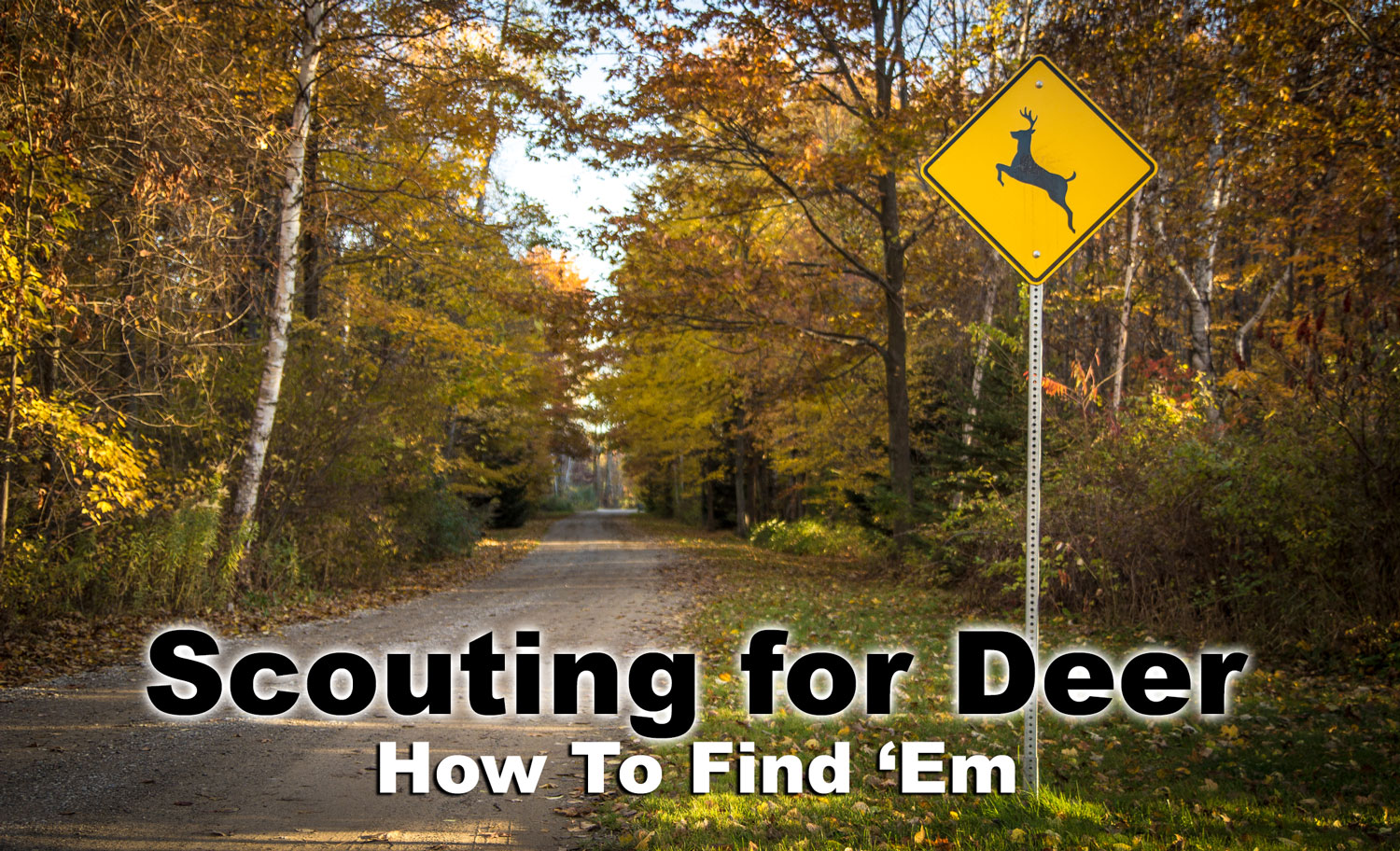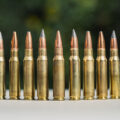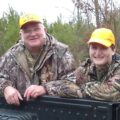The start of any successful hunt comes well before you grab your firearm and hit the woods or field. Let’s explore what goes into scouting for deer to give you a great shot at the buck you dreamed about all summer.
I was lucky enough to learn the basics of deer hunting from my dad. Season after season, I followed behind him in boots too big for my small feet. He was always careful to walk me through the pre-season scouting process, poring over maps and pointing out sign in the woods. I was pretty hard-headed, particularly in my teen years, but eventually things started to sink in. I’ve learned a lot about how to find deer. Both from my father’s patient teaching and my own success in the woods.
Here are the most important deer scouting skills both my dad and hard-earned experience have taught. Some are pretty obvious. Others might surprise you.
How to Find Deer: Use Maps to Scout
Locating deer on a piece of property can feel like locating a needle in a haystack. But scouting doesn’t have to be that daunting. You can narrow your search before you ever set foot in the woods. My dad used carefully folded topo maps he ordered through the mail. He would carefully spread them out on the kitchen table, running his fingers over the terrain to form a vivid picture of the woods in his mind. He could sense bedding areas and deer movement simply by looking at those flat pieces of paper.
The process is a lot easier for the modern hunter. With a basic internet connection, we have instant access to detailed maps and aerial images of almost any location on earth. Just go to Google.com and type in the name of your location (or one close by if you’ll be hunting a remote area). Click on the maps option at the top of your search results. Voilà! You have a free detailed map at your immediate disposal.
As a deer hunter, you’ll be most interested in the “satellite” view. If you don’t see it, there is an option (usually in the lower left corner) that allows you to toggle between the two settings. Google provides detailed satellite imagery that not only shows major roads, but also gives important information about cover, terrain, food, and water sources. With some practice, you can even distinguish between old hardwood groves and young pine thickets.
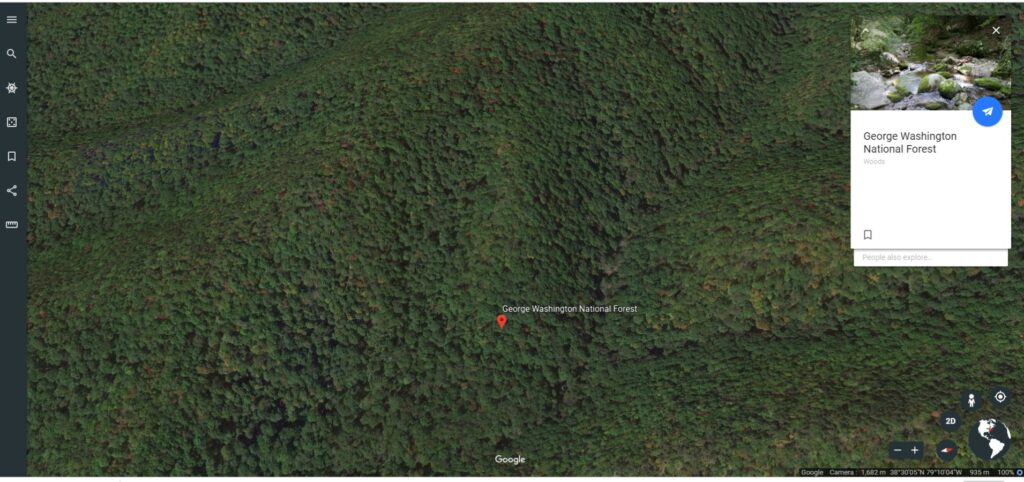
To really dive into serious online scouting, you’ll want to install Google Earth. It’s free and offers even more detail than the satellite views available from a simple Google search. With Google Earth, you can zoom in and change the map perspective. A few simple map adjustments allow you to change the viewing angle and get up close and personal with the lay of the land. For portable access, you can even download Google Earth on your mobile phone.
Of course, good old-fashioned topographic maps are still a thing. You can order them from the United States Geological Survey, either online or through the mail.
Study the Terrain
Topography influences deer movement more than you probably know. From the comfort of your computer chair, you can use digital or paper maps to locate features that affect whitetail activity. Look for features like these:
Ridges and Saddles
Traveling the top of mountain ridges is dangerous for deer because their outline is more visible against the skyline. For this reason, deer prefer crossing ridges in natural dips or “saddles” so they can stay better hidden. Hunting near one of these features increases the odds of seeing moving whitetails.
Hollows
A hollow is an elongated strip of low land between higher areas. For eastern flatlands, this could be a simple drainage area. In the mountains, hollows are more pronounced. Often called “gullies,” these low areas often serve as travel routes from higher bedding areas to lower feeding areas.
Dips and Ditches
If you’re hunting Eastern flatlands or Midwest plains, look for dips and depressions. These could be ditches or other low areas. Bucks use these areas to travel from one spot to another, especially when moving through open areas. The big boys like to stay hidden, and traveling a ditch line is common practice.
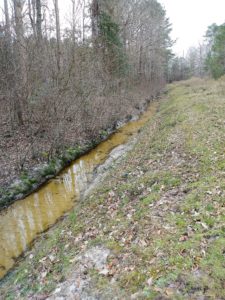
Power Lines
Power lines are a dream come true for rifle hunters, especially in areas with thick woods. Deer often feed on the tender green grass and other plants in these man-made meadows. Because power lines are wide open, they offer rifle hunters clear, unhindered shot corridors so get your .308 ammo and rifle ready. However, bucks often travel trails that run parallel to open power lines so they can stay hidden while getting a clear view of potential danger. For a bowhunter, a stand along these parallel trails can offer some golden opportunities.
Reading Deer Sign
While you can gather an awful lot of information from digital images, there’s nothing like the real thing. Eventually, you’ll need to get out there and use your own two eyes to determine where the deer are located. Hunters in open farming country can use direct observation. A casual drive near dawn or dusk can offer a valuable view of the local deer population. However, that usually isn’t enough. You’ll still need to get your boots dirty if you want to find the best hunting location.
Scouting for Deer: What to Look For
Trails
While deer trails are the most abundant sign in the woods, they have limited value. A trail simply shows where deer travel, not when or why, and those are important details. Once you’ve discovered a good trail, you’ll want to refer back to your satellite images or topo map. This can help determine why deer are using a trail. Is it a direct route between food and dense bedding areas? Is it an easy path around a water source or steep terrain? You’re going to need to use some sleuthing skills to determine if a trail is worth your time and attention.
Sometimes the best way to discover a trail’s purpose is to follow it. You may stumble upon an unknown food source or find other intersecting trails. Be careful, though. Walking along a deer trail can contaminate the area with human scent, warning deer to steer clear. It is best to follow a trail off to one side. Also, be sure to spray your clothes and boots with a scent eliminator spray.
Food
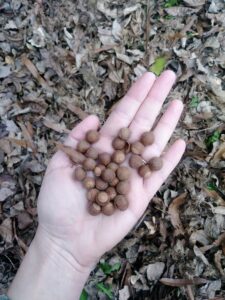
Believe it or not, deer are pretty sedentary creatures. Although whitetails are incredible athletes, they spend most of their time bedded down for safety. They really only spend a small portion of the day on their feet. When they are up and moving, most of their time is spent feeding. (Unless it’s the rut. Then they have love on their minds rather than food.)
If you can locate their food source, you can locate the deer. In agricultural areas, locating a food source isn’t a problem. Deer like an easy meal, and fields of corn, wheat, or soybeans are a whitetail’s all-you-can-eat buffet. In those cases, you should focus your scouting on routes deer are using to and from their autumn-tide smorgasbord.
If you’re hunting forests or open plains, things are a little more complicated. You’ll need to find concentrations of preferred natural foods. Deer are a lot like people and their favorite foods differ by regions. Just like southerners like fried chicken and sweet tea, while Texans would rather have some chili and smoked brisket, deer in different parts of the country prefer different fare.
You’ll need to learn what the deer in your area are eating. Ask experienced hunters if they are willing to share what they’ve learned about local food sources. To further complicate matters, food sources change with the seasons. Some across-the-board favorites, however, include acorns, apples, and persimmons. If you can locate a source for these delicacies, the deer will probably be close by.
Buck Sign
While does are nice for filling freezers and are a major part of any management program, big bucks are generally a deer hunter’s prime objective. Thankfully, bucks leave unique calling cards in the woods, and if you know what to look for, you can easily find them.
Scrapes
Scrapes are probably the most obvious sign of buck activity, although their value is questionable.
Bucks use scrapes as a way to communicate with other deer through scent. A buck makes a scrape by rubbing his nasal, preorbital, and forehead glands on overhanging branches, leaving behind his musky scent. When he’s done, he scrapes the ground with his feet. After pawing away the leaves, he urinates in the cleared spot.
Wildlife research confirms that buck scrapes are usually visited at night, so a stand near an active scrape will likely leave you disappointed. However, you can gather useful information from a buck scrape. First and foremost, a scrape means there is a buck in the area. Also, the first open scrapes signal the onset of the rut. If a scrape is visited regularly, it means rutting activity is increasing. Since bucks tend to get careless during the rut, this is good news for deer hunters.
Rubs
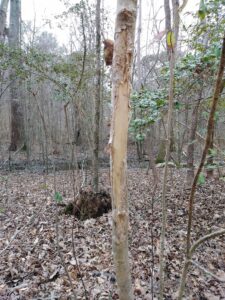
Rubs are not typically revisited by deer. However, just like scrapes, they provide important information about bucks in the area. If you find rubs that have obviously been used year after year, this means there is a big mature buck in the area.
Rub lines also provide important information. When rubs are spaced out along a trail, this is called a rub line. A rub line is a clear indication a buck travels that route. If you can combine this with other information you’ve gathered about movement and food sources, it can start to paint a clearer picture of buck activity.
Tracks and Scat
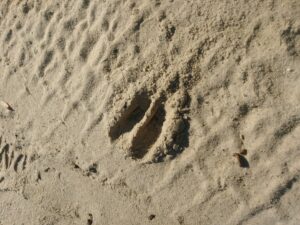
Scat may not confirm there is a buck nearby, but they do reveal something about the particular deer that left them. For example, deer droppings left in large clumps indicate they were deposited by a large deer. That large deer could be a big buck, but it could just as likely be a mature doe. However, there is more information here than the size of the deer responsible for that pile of poop. Since mature deer commonly defecate immediately after leaving their beds, droppings near thick brush could indicate a bedding area, as well as which way the deer is traveling after leaving the bed.
Deer tracks can also provide important information, though understanding how to read them can be tricky. Knowing how to age a track is an essential skill. Some tracks can be days (or even weeks) old and only indicate a deer passed through at some point. Fresh tracks are more valuable, indicating a deer may still be nearby. Fresh tracks have sharp, clear edges. They will also be free of debris and the freshest tracks may still feel moist inside.
Chances are good that the largest tracks are left by bucks. However, a large track isn’t a guarantee of a monster buck. I’ve seen some hefty prints left by big, well-fed does. A better tell is how many tracks you find. Does tend to travel in groups, so if you find a single set of large prints, they were probably made by a buck.
How to Find Deer: Be a Ninja
Too much scouting in an area can actually hurt your hunt. Human presence makes deer skittish and too much human activity can actually push deer out of the area. While you are scouting, be careful to leave little evidence of your presence. Use products that help minimize human scent. Wear rubber boots without a deep tread to minimize the footprints you leave behind. Be sure to wash those boots with scent control soap and spray them with a scent eliminating product before and after you scout.
Remember scouting isn’t about getting close to deer. Save that for hunting season. If you know there are deer in the area, you don’t need to lay eyes on them. If you do happen to see deer, be still and wait until they are well out of sight before moving on. You don’t want to disturb their regular routine if you can help it.
Once you have the information you need, stay away from your hunting area. This is especially important during the weeks leading up to opening day. Human pressure can make deer change their patterns, and if that happens, all your hard work will have been for nothing.
Deer Stand Placement
You don’t want to stumble into the woods on opening day with no idea where the deer might be. While even a blind dog finds a bone sometimes, doing your homework will increase your odds of filling your tags. By studying the lay of the land and the evidence deer leave behind, you can start to form a picture of how deer in the area live their lives. Once you have that picture, it’s easier to know where to place your deer stand.
There really is no “perfect spot” to place a deer stand. The whitetail population is just as varied as their habitat. The characteristics of a great hunting spot in the West Virginia mountains just won’t translate for Mississippi swamp bucks. The key is to understand the local deer population, and sometimes that just has to come through experience.
However, using these scouting tips will help. Once you’ve located some hot spots and identified travel routes, you can set up a stand nearby. Remember, deer are relatively sedentary, so you want to situate your stand to catch them on the move.
Obviously, there are more variables involved. Weather conditions, moon phases, scent control, and the rut, all influence movement patterns. Deer hunting is a complex sport. But it wouldn’t be called “hunting” if success was guaranteed. With these tips you’ll at least have some idea of how to find deer and have the chance of getting a shot.
Are there other methods or practices you use to find deer? We’d love to hear them in the comments. They could help a fellow hunter get on the right path to bagging a buck!
